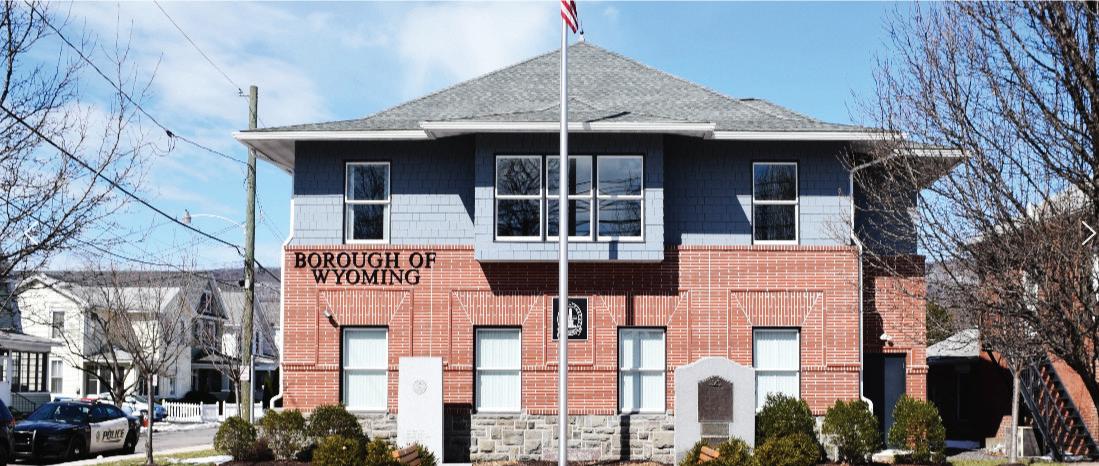
3 minute read
What’s In A Name: Indiana and
Indiana and Wyoming, Pa.
By RAY BALOGH | The Municipal
In America travelers can take a road trip from Washington, Kan., to Kansas, Ill.; Oregon, Ohio, to Ohio, Colo.; Virginia City, Nev., to Nevada, Iowa; or Hawaiian Gardens, Calif., to California, Mo.
Pennsylvania leads the nation in cities incorporating the names of other states, with nine such municipalities, followed by Illinois and Missouri with eight each and Ohio with seven.
Pennsylvania’s cities are California, Indiana, Mainesburg, Ohiopyle, Ohioville, Washington, Washingtonville, Washington Township and Wyoming.
Outside the Indiana County courthouse stands a marker honoring hometown notable Jim Nance, an NFL fullback who played in the league from 1965 to 1975 and was inducted into New England Patriots Hall of Fame in 2009. (Photo courtesy of indianacountypa.gov) Wyoming, Pa., is included in the Scranton/Wilkes-Barre metropolitan area. Its population peaked in 1940. (Photo courtesy of wyomingpa.org)
INDIANA
The borough of Indiana is the county seat of its namesake, Indiana County, and has been considered part of the Pittsburgh metropolitan area since 2013.
The name Indiana derives from the purchase of the land from the Iroquois Six Nations in the first Treaty of Fort Stanwix signed in 1768.
The borough was founded in 1805 on acreage granted by George Clymer, one of six Founding Fathers to sign both the Declaration of Independence and the U.S. Constitution. By 1810, the population was 125.
The city, with a current population of 13,017, is most famous for being the birthplace and boyhood home of beloved iconic actor Jimmy Stewart. Indiana and its surrounding region is also the selfdeclared “Christmas Tree Capital of the World,” a designation it adopted in 1956, the year the Christmas Tree Growers Association was founded in the area.
Some of the first tree farms in the United States started in Indiana County as early as 1918. Many farmers in the region jumped aboard the profitable venture, and by 1960, more than 1 million Christmas trees were harvested each year in the county.
Stewart was born in Indiana on May 20, 1908, and lived at 104 N. Seventh St. through high school. The town gave Stewart a 75th birthday celebration on May 20, 1983, and opened The Jimmy Stewart Museum downtown on May 20, 1995, two years before the legend passed away.
Stewart visited his hometown many times during his life and said about the museum, “Entering a building which houses a museum named after me is a privilege I could never have anticipated. I hope its visitors will enjoy their stay there. After all, they are the ones who really built it.”
For more information, visit indianacountypa.gov or indianaboro.com.
WYOMING
Wyoming, a borough of 2,990 residents 5 miles north of WilkesBarre in northeast Pennsylvania, was first inhabited in the 1700s by several Native American tribes, including the Susquehannock and the Delaware. By the mid-18th century, settlers from Connecticut had ventured into the surrounding Wyoming Valley.
The young settlement had a violent beginning. On July 3, 1778, British forces, aided by about 700 Native Americans, ambushed an American militia near Forty Fort. In the one-day battle, more than 300 settlers had been killed, and the next day Col. Nathan Denison agreed to surrender the fort and other posts.
Today in the borough stands a monument, constructed in the early 1830s, marking the gravesite of the battle’s victims. The monument is listed on the National Register of Historic Places. Every year Wyoming holds an observance honoring the fallen heroes of the Revolutionary War battle known as the Wyoming Massacre.
Wyoming was officially incorporated in 1885 with a population of approximately 1,500. The borough’s census peaked in 1940 at 4,648 and has gradually declined since.
A flood in 2011 prompted the evacuation of the Wilkes-Barre Wyoming Valley Airport and planes were moved to higher ground, then relocated at the Wyoming Monument.
For more information, call (570) 693-0291 or visit wyomingpa.org.












